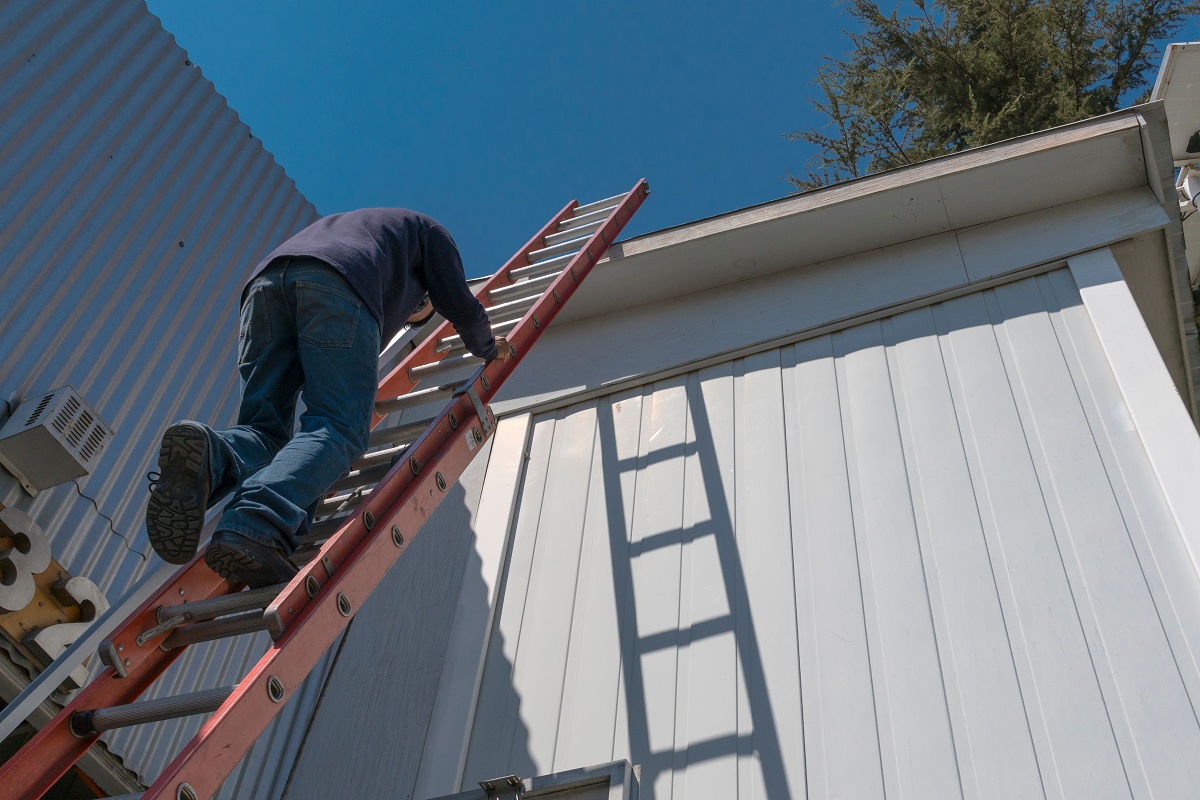Working at height is still one of the leading causes of fatalities and major injuries. Many builders, electricians, roofers, and other construction workers work at height every day. Employees and businesses alike must be aware of the health and safety risks for jobs that involve working at height to ensure measures are in place to avoid any accidents.
Whilst equipment can be used to protect materials on a construction site, such as door protection for frames, what can be done to improve safety for people working at height?
In this article, we look at what working at height is, the most common safety risks, and the risk assessment for working at height that needs to be carried out.
What does working at height mean?

In their guide about working at height on the HSE website, the government agency states: “'Work at height' means work in any place where, if there were no precautions in place, a person could fall a distance liable to cause personal injury (for example a fall through a fragile roof).”
ALSO READ: Weatherproofing your construction site through the seasons
What are the safety risks of working at height?

Many hazards need to be considered when it comes to working at height, and here we take you through some of the major risks.
Falling from a height
One of the most common safety risks of working at height is falling. The results from a fall can range from cuts and bruises to serious injuries and even fatalities. If someone falls from a height, the consequences can be severe, and it is important that a working at height risk assessment is done on any construction site.
Tools and materials being dropped from a height
Another common safety risk is tools being dropped from a height and striking people who are working on the ground. The risk of dropping tools from a height is not uncommon, and the risk is increased when materials or equipment are moved.
Depending on what has fallen and the height from which it fell, equipment being dropped is extremely serious and can cause fatalities and injuries.
Equipment not being stored properly
Equipment that is not put away properly can become a hazard, causing trips, slips and falls. For example, if tools or materials are just left lying on the floor of scaffolding or anywhere at a height, someone might not see it and could trip over, potentially falling from the area they are working on.
It is vital that any tools, materials or clutter are put away and not left on the floor, as this will help prevent accidents from occurring.
If you are working with scaffolding, you should also consider using hi-vis scaffold protector tubes to alert pedestrians and employees to take care. These scaffold protector tubes are recommended to be used by Health & Safety authorities.
Falls from ladders
Using ladders is a necessity for painters, electricians, and builders, but unfortunately, falling from a ladder is extremely common. There are many risk factors that you need to consider when using a ladder, which range from slipping whilst climbing to the ladder falling over whilst you are on it.
Commodious, who offer online health, safety and compliance courses, spoke about the requirements a ladder needs to meet: “Anyone supplying a ladder for work must ensure that it meets the requirements of PUWER, i.e., it must be:
- Suitable for use and for the purpose and conditions in which it is to be used
- Maintained in a safe condition for use so that people’s health and safety are not at risk
- Inspected, in certain circumstances, to ensure that it is and continues to be safe for use. Any inspection should be carried out by a competent person (this could be an employee if they have the necessary skills, knowledge and experience to perform the task) and a record kept until the next inspection.”
If you are using a ladder on a site, it is also important that you consider using safety equipment like ladder guards as these can help to prevent unauthorised access and keep a ladder locked in place.
Human error
Human error is another common cause of falling from a height. This can range from not securing equipment properly or not following the safety procedures that have been put in place.
It is vital that if a person working from a height lacks experience, they are made aware of the potential risks, have the proper training to help them deal with those dangers, and have the equipment they need to keep them safe.
Unguarded openings and fragile surfaces
Unguarded openings or gaps in the area you are working in can be a serious hazard, and these openings should ideally have fall protection covers in place. Ladder access hatches are a vital piece of equipment, especially if you are working on construction sites before stairs have been installed, as this can help protect against any falls.
A fragile surface is another major risk of working at height. It is not uncommon for you to work on a fragile roof, for example, and here the risk is that the roof could collapse with you on top of it.
It is vital that if you are working on fragile roofs or surfaces, thorough checks are carried out, and the surface is inspected to see how unsafe it is.
Electrocution
Working at height can increase the risk of electrical hazards, such as coming into contact with overhead power lines.
The HSE shares some tips for people to follow who are working near power lines: “When arboricultural (aerial and ground) works are proposed within 10m (measured at ground level horizontally from below the nearest wire) of overhead power lines, a risk-based approach needs to be adopted. In practice, this means that you should seek specialist advice and guidance from the owner of the power line (Network Operator) before undertaking any work within this distance.”
ALSO READ: The importance of PPE gloves for construction
How to minimise the risks of working at height?

Carry out a risk assessment for working at a height
Before starting a job that requires you to work at a height, you need to first carry out a risk assessment for working at a height. Here are five steps that a typical risk assessment should follow:
- Identify any hazards
- Decide who may be injured, along with what that injury would look like
- Evaluate the risks and decide on precautions
- Record your findings and implement them
- Review and revise your risk assessment if necessary (usually after an event or change)
Organise a working-at-height rescue plan
A working-at-height rescue plan is a pre-planned procedure designed to be used in the event of a fall from a height. Any company, business or workplace where employees work from a height should have a rescue plan in place.
The HSE says that working at height rescue plans should consider the following:
- The safety of all individuals carrying out the rescue.
- Information about the anchor points for the safety equipment.
- The suitability of any equipment.
- How the individual will be attached to the rescue equipment.
- How the individual will be moved using the rescue equipment.
- Information about any medical needs or other needs of the individuals involved in the rescue.
Health and safety training
Ensuring that everyone in the business or on a construction site has received health and safety training is vital when working towards avoiding harm at work.
This can minimise potential risks and hazards for everyone on a construction site and allow workers to carry out their job safely.
Many training courses are available, and you can even do them online.
ALSO READ: What is SSSTS? Site Supervision Safety Training Scheme explained
Here at Proguard, we offer protection products for every construction job, ranging from floor protection to window protection, so browse through our products to help you create a safe and professional work environment.
For more tips, guides, and advice, visit our news page.






